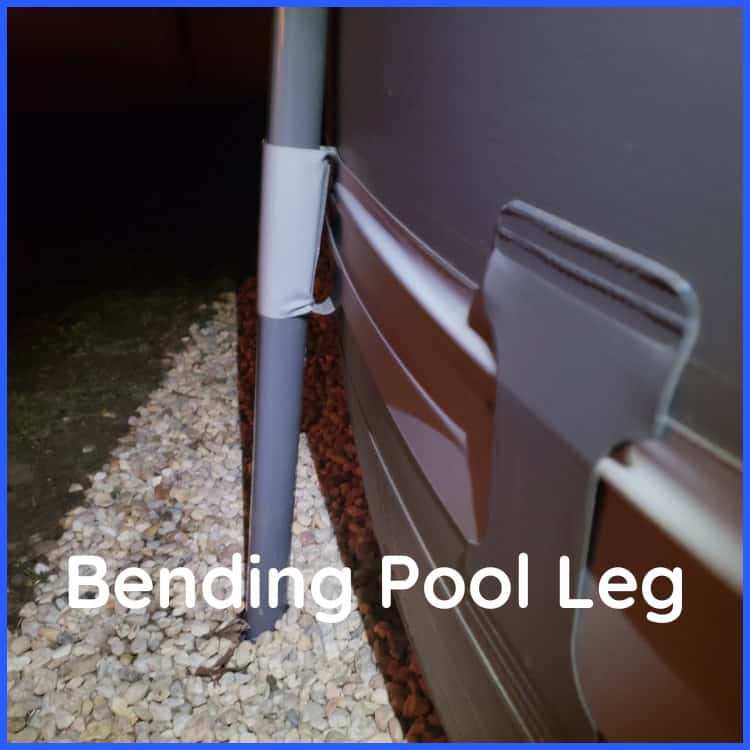Intex Pool Legs Not Straight or Leaning? (Solution)
If your Intex pool legs aren’t straight and are bent or leaning, the most common reason is the ground is uneven. The quickest way to solve this is by jacking the pool legs up and placing pavers, wooden blocks, or foam blocks underneath. Alternatively, sand can be used to level out the surface, but this is messy.
Less likely but also possible reasons for the leaning include water leveling problems, such as overfilling. It is also possible the legs were installed incorrectly during erection or you just have a faulty leg.


In either case, I’ll go through the problem of leaning Intex legs below and provides some quick solutions (with photos and videos where possible).
Are Leaning Intex Pool Legs Always a Problem?
Leaning or bent pool legs are not always a problem. Depending on how severe the bends are, you can leave them as long as you’re not thrashing about in the pool or leaning on the sides.
If you drain and take the pool down every winter, you might be able to get away with it for the summer. Again, just be careful.
However, if the leg is leaning out more than 2 inches, I will recommend that you solve the problem quickly. The leg will kick out over time and it will happen gradually until the wall collapses.
What Can Happen if the Legs are Bent Too Much?
If you leave the pool with incredibly bent legs, you could cause several more severe issues.
- Tears and Permanent Damage to Pool Walls
- The goes without saying but if you leave the legs bent for too long, the integrity of the pool wall could fall. This could result in the pool wall lining tearing, allowing water to spill out. It could also result in the entire wall collapsing, leading to a complete above ground pool (AGP) placement.
- Folds, Tears, and Wrinkles in the Pool Liner
- Not many people know this, but leaning Intex pool legs can cause problems to the floor liner as well.
- If the pool is leaning to one side as a result of uneven ground, the liner will wrinkle and fold. If the leaning is very severe, the floor could tear as well.
- Risk of Injury (Especially Children)
- Of course, all the above could result in several injuries, especially if someone is in the pool at the time. Adults are at risk, but the ones who could get seriously injured are children.
So, it’s best to solve these issues early if you can. Even if the leg is off by an inch, it’s best not to leave it to fate.
Place Pavers Under the Legs
The easiest way to solve a bent or leaning Intex pool leg is by jacking it up and placing a paver or block underneath.
Don’t have access to pavers?
See my guide on the best thing to put under above ground pool legs.
A bent leg is usually the result of uneven ground. So, to combat the slope your AGP is on, pavers can be placed underneath to level out.
Be Cautious When Doing This
I have read stories of the 2×4 popping out of place when jacking and injuring people. So, take this slow and if you’re not confident, there are alternative methods
The Step-by-Step Process
To start with, I always recommend draining the pool either completely or by 70%. However, you can do this with the pool full, but you risk breaking a T fitting or tearing the liner.
Identify the legs that are bent and get yourself a floor jack and a 2×4 block of wood. Place the 2×4 upright, leaning it or placing it against the leg just below the T fitting.
Use the Right Jack!
It’s very important to use the correct jack when doing this. Don’t use a bottle jack as the lifting head is tiny and the footprint is too small. Always use a floor jack.
Place the lifting head underneath the bottom end of the 2×4 and start jacking up the leg until it is level with the rest of the other legs and edges. If the jack starts to sink under load, stop what you’re doing and place a paver or block under the jack to prevent it from moving.
Grab yourself a concrete paver, a wooden block, or a foam block (if you’re on concrete), and place it between the leg and the ground. Make sure it fits, and if it doesn’t you can use two blocks or a thicker item.
Repeat this process with other bent legs until you have a nice, straight Intex pool.
Here’s a more detailed video on how to do this:
Dig and Level the Ground
If you want a permanent but physical solution, you can dig into the high point of your ground and level out the floor that way. Although this is a long-winded approach, it is very effective and reduces pool lining damage.
When you’re looking at your wonky legs, identify where the high point is. Then take down the pool and start working on the ground underneath that section.
You’ll want to effectively dig a ledge that the pool will fit into. You’ll want to dig down until you have leveled the earth with the lowest point of the ground. Hopefully, that makes sense.
Make sure to compact all the earth below the pool before you start putting it back up. You don’t want to dig down to soft mud only for the pool legs to sink and bend again.
When you go to test the level of the pool, only fill the pool with a few inches. This way, you can monitor and adjust the legs if they’re still out by an inch or so; saving you from having to re-fill and drain fully.
Try Using Sand to Level the Legs
A messy but sometimes effective approach is to use sand under the Intex pool to level the ground. This has the benefit of solving the uneven ground at the source It also means you don’t risk damaging your pool with the jacking method described above.

To do this, you’ll need to drain and take down the Intex pool entirely, which is a bit of a pain. Then, identify where the ground is uneven and use a large bag of sand to level it out.
To ensure it’s smooth, use a shovel to compact the sand and make sure the surface is straight. Once all of that is complete, put up the pool and see if the legs are straight. If not, repeat the above steps.
The Problems with this Approach
The real problem with the sand leveling approach is the mess and unpleasant aesthetic it produces. It can also take a few goes before you get the pool somewhat level. Especially if the pool is on a severe slope or angle. Also, the sand isn’t effective if you splash about a lot in the pool, as it will push and wash away.
The Legs Were Placed Incorrectly During the Construction
Sometimes a bent or leaning Intex pool leg is simply the result of a faulty setup. If you haven’t positioned placed the leg when you were erecting the pool, it could start to bend.
The easiest fix to this is to take down the pool and put it up again, making sure you’re following the instructions or working with someone who has put up an AGP before.
I’ve read of people thinking they have a leveling problem when instead they’ve positioned the leg incorrectly. So, when they went to jack up the lower side, they ended up causing too much strain on the lining, resulting in a tear.
So, always make sure you’ve set the pool up correctly before taking drastic measures!
Drain the Pool Slightly
The legs can start to bend if the pool is filled too high. This can happen from heavy rainfall or because you weren’t paying attention during the filling process.
Excessive water can cause the bag to expand, pushing the legs outwards. Additionally, if there are already slight leveling issues, the increased water pressure will make the problem worse.
If this is the case, drain the pool slightly to relieve some of the pressure on the lining bag. Make sure the pool is correctly filled to what the manufacturer specifies.
Replace if the Leg is Old or Faulty
If you’ve had the Intex pool for a while, you might just have a faulty or rusty leg. If the leg looks like it’s seen better days, you might need to get a replacement.
If your legs have started to rust or buckle, all it might take is a harsh thunderstorm or a strong gust of wind to damage its structure – resulting in the bends you could be seeing.
Don’t go buying new legs just yet though. Try the strategies detailed above and if no matter what you do results in straight pool legs, get yourself some replacement.
Need Recommendations?
If you need cheap pool leg replacements, I’ve always found these Coleman/Bestway legs to do the trick.
